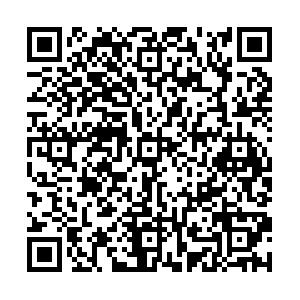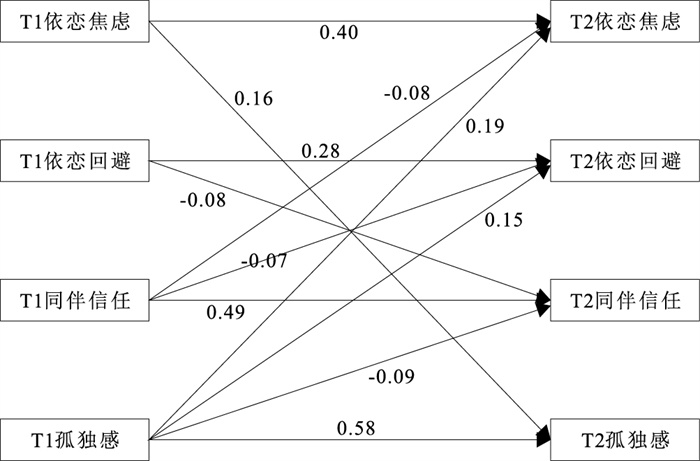Interaction between peer attachment, peer trust and loneliness in the first-year senior high school students
-
摘要:
目的 探讨同伴依恋、同伴信任与孤独感的纵向关系,为青少年心理健康工作的高效开展提供参考。 方法 采用方便抽样的方式选取贵州和山东2所高中的高一年级学生1 013名为研究对象,采用纵向研究设计,使用亲密关系体验-关系结构量表(ECR-RS)、同伴信任量表与孤独感量表,分别于2020年11月、2021年12月(T1)与2021年1月、2022年1月(T2)对学生进行问卷调查。 结果 T1和T2两个时间点的同伴信任与依恋焦虑、依恋回避、孤独感均呈负相关(r=-0.50~-0.17,P值均 < 0.01),依恋焦虑、依恋回避及孤独感间均呈正相关(r=0.11~0.41,P值均 < 0.01)。T1依恋焦虑能正向预测T2孤独感(β=0.16,P < 0.01),T1孤独感能正向预测T2依恋焦虑、依恋回避(β值分别为0.19,0.15,P值均 < 0.01);孤独感的稳定性相关系数大于依恋焦虑(CR=7.12,P < 0.01),而同伴信任的稳定性相关系数大于依恋回避(CR=2.40,P < 0.01)。 结论 孤独感单向影响依恋回避和同伴信任,但与依恋焦虑间相互影响,且影响更大,心理干预应从减少孤独出发,促进依恋的发展。 Abstract:Objective To explore the longitudinal relationship between peer attachment, peer trust and loneliness, and to provide reference for the effective adolescent mental health promotion. Methods A convenient sampling method was used to select 1 013 first-year senior high school students from 2 high schools in Guizhou Province and Shandong Province. A longitudinal design was adopted. The Revised Experiences in Close Relationships-relationship Structures Scale(ECR-RS), Trust Scale and University of California at Los Angels Loneliness Scale were administered in Nov. 2020, Dec. 2021(T1), as well as in Jan. 2021 and Jan. 2022(T2). Results Peer trust at two time points was negatively correlated with attachment anxiety, attachment avoidance and loneliness(r=-0.50--0.17, P < 0.01), while attachment anxiety, avoidance and loneliness were positively correlated(r=0.11-0.41, P < 0.01). T1 attachment anxiety significantly predicted T2 loneliness(β=0.16, P < 0.01), and T1 loneliness significantly predicted T2 attachment anxiety and avoidance(β=0.19, 0.15, P < 0.01). Correlation between stability of loneliness was higher than attachment anxiety(CR=7.12, P < 0.01). Correlation between stability of peer trust was higher than attachment avoidance(CR=2.40, P < 0.01). Conclusion Loneliness affects attachment avoidance and peer trust unidirectionally. There is mutual influence between loneliness and attachment anxiety, with larger impact from loneliness. Intervention aiming for attachment promotion might consider loneliness reduction. -
Key words:
- Object attachment /
- Loneliness /
- Mental health /
- Students
1) 利益冲突声明 所有作者声明无利益冲突。 -
表 1 近1月内报告同伴变化分组青少年依恋、同伴信任与孤独感比较(x±s)
Table 1. Comparison of peer attachment, peer trust and loneliness in adolescents among group that reported peer changes in the past 1 months(x±s)
是否换同伴 人数 T1依恋焦虑 T2依恋焦虑 T1依恋回避 T2依恋回避 T1同伴信任 T2同伴信任 T1孤独感 T2孤独感 是 468 3.13±1.64 3.10±1.55 2.87±1.33 3.01±1.40 4.76±0.99 4.45±0.95 2.19±0.48 2.23±0.47 否 545 3.01±1.47 3.10±1.44 2.76±1.24 2.85±1.27 4.79±0.89 4.57±0.85 2.13±0.42 2.15±0.42 t值 1.22 0.03 1.30 1.85 -0.44 -2.22 2.16 3.39 P值 0.22 0.98 0.19 0.07 0.66 0.03 0.03 < 0.01 表 2 青少年同伴依恋、同伴信任与孤独感相关分析(r值,n=1 013)
Table 2. Correlations between peer attachment, peer trust and loneliness in adolescents(r, n=1 013)
变量 T1依恋焦虑 T2依恋焦虑 T1依恋回避 T2依恋回避 T1同伴信任 T2同伴信任 T1孤独感 T2依恋焦虑 0.49 T1依恋回避 0.14 0.11 T2依恋回避 0.18 0.24 0.38 T1同伴信任 -0.30 -0.23 -0.50 -0.28 T2同伴信任 -0.17 -0.19 -0.35 -0.33 0.55 T1孤独感 0.40 0.35 0.38 0.31 -0.32 -0.27 T2孤独感 0.38 0.41 0.26 0.38 -0.22 -0.27 0.63 注:P值均 < 0.01。 -
[1] ARCHIBALD F S, BARTHOLOMEW K, MARX R. Loneliness in early adolescence: a test of the cognitive discrepancy model of loneliness[J]. J Pers Soc Psychol, 1995, 21(3): 296-301. doi: 10.1177/0146167295213010 [2] 安容瑾, 姜永志, 白晓丽. 青少年社交网络使用与孤独感的关系: 在线积极反馈与积极情绪的多重中介[J]. 中国临床心理学杂志, 2020, 28(4): 824-828, 833.AN R J, JIANG Y Z, BAI X L. The relationship between adolescent social network use and loneliness: multiple mediations of online positive feedback and positive emotions[J]. Chin J Clin Psychol, 2020, 28(4): 824-828, 833. [3] 雷雳, 伍亚娜. 青少年的同伴依恋与其互联网使用的关系[J]. 心理与行为研究, 2009, 7(2): 81-86. doi: 10.3969/j.issn.1672-0628.2009.02.001LEI L, WU Y N. Adolescents' peer attachment and their Internet use[J]. J Psychol Behav, 2009, 7(2): 81-86. doi: 10.3969/j.issn.1672-0628.2009.02.001 [4] BRENNAN K A, CLARK C L, SHAVER P R. Self-report measurement of adult attachment: an integrative overview[M]. New York: The Guilford Press, 1998: 46-76. [5] MOURA-RAMOS M, SANTOS T A, CANAVARRO M C. The role of attachment anxiety and attachment avoidance on the psychosocial well-being of infertile couples[J]. J Clin Psychol Med S, 2017, 24(2): 132-143. doi: 10.1007/s10880-017-9496-9 [6] MIKULINCER M, SHAVER P R. Attachment security, compassion, and altruism[J]. Curr Dir Psychol Sci, 2005, 14(1): 34-38. doi: 10.1111/j.0963-7214.2005.00330.x [7] NICKERSON A B. Parent and peer attachment in late childhood and early adolescence[J]. J Early Adolesc, 2005, 25(2): 223-249. doi: 10.1177/0272431604274174 [8] AKDOAN R. A model proposal on the relationships between loneliness, insecure attachment, and inferiority feelings[J]. Pers Individ Differ, 2017, 111: 19-24. doi: 10.1016/j.paid.2017.01.048 [9] GORRESE A, RUGGIERI R. Peer attachment: a Meta-analytic review of gender and age differences and associations with parent attachment[J]. J Youth Adolesc, 2012, 41(5): 650-672. doi: 10.1007/s10964-012-9759-6 [10] 钟歆, 刘聚红, 陈旭. 青少年同伴依恋: 基于发展的视角[J]. 心理科学进展, 2014, 22(7): 1149-1158.ZHONG X, LIU J H, CHEN X. Adolescent peer attachment: a developmental perspective[J]. Adv Psychol Sci, 2014, 22(7): 1149-1158. [11] FRALEY R C, HEFFERNAN M E, VICARY A M, et al. The experiences in close relationships-relationship structures questionnaire: a method for assessing attachment orientations across relationships[J]. Psychol Assess, 2011, 23(3): 615. [12] 彭小凡, 罗长群, 王颖, 等. 亲密关系体验-关系结构量表(ECR-RS)中文版测评大中学生的效度和信度[J]. 中国心理卫生杂志, 2020, 34(11): 957-963. doi: 10.3969/j.issn.1000-6729.2020.11.012PENG X F, LUO C Q, WANG Y, et al. The Chinese version of the Experiences in Close Relationships-relationship Structures Scale(ECR-RS) assesses the validity and reliability for middle school and college students[J]. Chin Ment Health J, 2020, 34(11): 957-963. doi: 10.3969/j.issn.1000-6729.2020.11.012 [13] AMANDA V. Attachment facilitates acculturative learning and adversity moderates: validating the theory of epistemic trust in a natural experiment[J]. Child Psychiatry Hum Dev, 2020, 51(3): 471-477. doi: 10.1007/s10578-020-00958-x [14] 汪向东, 王希林, 马弘. 心理卫生评定量表手册(增订版)[M]. 北京: 中国心理卫生杂志社, 1999.WANG X D, WANG X L, MA H. Manual of Mental Health Rating Scale(updated edition)[M]. Beijing: Chinese Mental Health Journal, 1999. [15] RUSSELL D W. UCLA Loneliness Scale(Version 3): reliability, validity, and factor structure[J]. Pers Assess, 1996, 66(1): 20-40. doi: 10.1207/s15327752jpa6601_2 [16] 叶宝娟, 周秀秀, 夏扉. 拒绝敏感性、情绪表达矛盾和孤独感的关系: 个体为中心的视角[J]. 中国临床心理学杂志, 2021, 29(3): 614-617.YE B J, ZHOU X X, XIA F. The relationship among rejection sensitivity, ambivalence over emotion expression and loneliness: a latent profile analysis[J]. Chin J Clin Psychol, 2021, 29(3): 614-617. [17] 苏志强, 邵景进, 张大均, 等. 童年中晚期友谊质量与抑郁的关系: 一项纵向研究[J]. 心理发展与教育, 2017, 33(4): 449-456.SU Z Q, SHAO J J, ZHANG D J, et al. The effects of relationship and self-concept on meaning in life: a longitudinal study[J]. Psychol Dev Educ, 2017, 33(4): 449-456. [18] 张荣伟, PUAL T P, 李丹. 人际关系和自我概念对生命意义的影响: 一项追踪研究[J]. 心理科学, 2020, 43(5): 1154-1161.ZHANG R W, PUAL T P, LI D. The relation between friendship quality and depression during middle and late childhood: a longitudinal analysis[J]. Psychol Sci, 2020, 43(5): 1154-1161. [19] SHIN S H, SOK S R. A comparison of the factors influencing life satisfaction between Korean older people living with family and living alone[J]. Int Nurs Rev, 2012, 59(2): 252-258. -







 下载:
下载:

